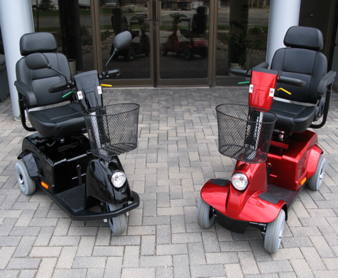Share:
Past Clinical Corner articles have looked at Power Assist Wheelchairs and Power Wheelchairs. Let's continue our look at powered mobility by focusing on scooters this month. We will look at clinical considerations in determining if a scooter is an appropriate mobility device for an individual and look at the essential components of a scooter to better understand this mobility device.
Scooters are either three- or four-wheeled, electric mobility devices that provide standard seating and have handles on a tiller for steering. Refer to the photo below.

There are a number of different factors to consider when deciding if a scooter is an appropriate electric mobility device for an individual. An individual must have the physical ability to steer the scooter through the handles and either depress or pull the levers to activate the forward/reverse actions. Usually, individuals who use scooters are independent in their transfers on/off the scooter. The seat on the scooter is able to swivel to the side to facilitate transfers, if required. Since the seat of a scooter is designed for comfort when using the scooter, rather than for specific positioning or pressure management, individuals who use scooters should not have any positioning or additional seating needs, such as the need for a pressure management cushion. Anticipation of future change in condition or function and the possible need to use wheelchair seating is taken into consideration as to whether a scooter is an appropriate device at the present time and for the foreseeable future.
Determining how the electric mobility device will be used will help to decide if a scooter is the most appropriate choice for an individual. A scooter tends to have a larger turning radius than a power wheelchair, which means that often a scooter is less maneuverable in tight spaces compared to a power wheelchair. In addition, because of the position of the front wheel(s) and tiller, it can be difficult for an individual to get close to objects, such as sinks or counters, from the front of the scooter. Scooters often are used outside of the home, where the space permits and where distances travelled are greater.
Once it is determined that a scooter is the most appropriate electric mobility device for an individual, next comes the comparison between models to determine which model is best suited for an individual.
In choosing between 3-wheeled and 4-wheeled scooters, 2 distinguishing factors are maneuverability and foot position. As the above photo suggests, a 3-wheeled scooter will allow an individual to get into tighter spaces due to the centre position of the front wheel and the tapered front end. A 3-wheeled scooter also tends to have more space available to position the feet. In a 4-wheeled scooter, the shroud covering the 2 front wheels may limit foot positioning for some individuals.
Four-wheeled scooters, however, are the more popular choice in Canada. Aesthetics may play a factor. In addition, some individuals may feel more confident driving a 4-wheeled scooter as it relates to stability, or perceived stability, due to the four wheels on the ground. Although the stability of a mobility device can be a complex subject (and the topic of a future Clinical Corner article), both 3- and 4-wheeled scooters have the potential to tip under certain conditions, making it important to select a device based on the needs of the individual. Driver education is important as with good driving practices, individuals can be safe using 3- or 4-wheeled scooters.
Other differentiating features of scooters are the size of motors and batteries, the amperage of the controller, and suspension in the unit. This is where scooters are very much like their power wheelchair cousins. Just as power wheelchairs can have 2-pole or 4-pole motors, scooters can also come with a 2- or 4-pole motor. Just as power wheelchairs can have different battery sizes, which affects the distance that can be travelled on a single charge, scooters also come with different battery sizes. (Please refer to the links above for more information on motors and batteries.) Another differentiating feature when comparing models of scooters is the suspension in the scooter and how it works to provide a smooth ride for the individual.
When thinking about the differentiating features of a scooter, one should think about the different ways the scooter will be used. If the scooter is primarily for indoor use or on flat terrain, the needs will be very different than if the scooter will be used in a hilly, outdoor environment, where more robust features are needed to get the required performance from the scooter.
A final thought about scooters is in thinking about how the device will be transported and stored. Scooters need to be stored near an electric outlet to allow charging of the batteries. Depending on the size of the unit to be transported and the type of vehicle being used to transport the scooter, ramps or vehicle modifications may be required to transport the vehicle. Whether using public or private transit, the scooter should be tied down and the individual should transfer to a regular seat as a scooter is not designed or tested for occupied transit.
This month, we have looked at scooters – the electric mobility cousin of power wheelchairs. We have looked at some of the factors that determine if a scooter is an appropriate mobility device for an individual and the features that differentiate scooters when trying to choose between several different models.